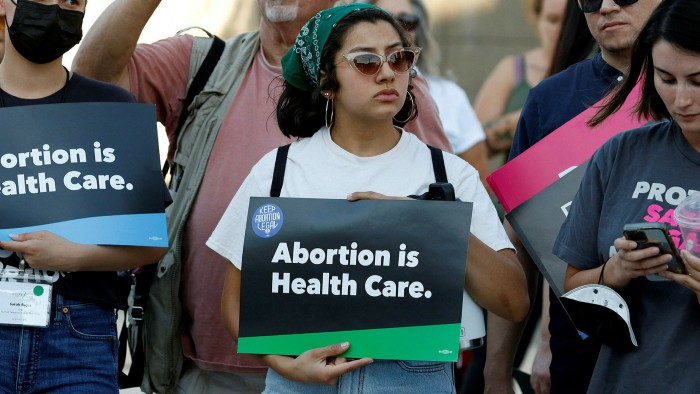The US Supreme Court’s blind spots on abortion


Roula Khalaf, Editor of the FT, selects her favourite stories in this weekly newsletter.
This article is an on-site version of Martin Sandbu’s Free Lunch newsletter. Sign up here to get the newsletter sent straight to your inbox every Thursday
Less than a week ago, the US Supreme Court overturned its own past decisions — above all the canonical Roe vs Wade ruling — that for the past half-century have constitutionally guaranteed American women’s right to end their pregnancies. Overnight, abortion became illegal in a number of states. According to a count by the New York Times, a complete ban on terminating pregnancy already is or soon will be in effect in 16 states.
The ruling in Dobbs vs Jackson Women’s Health Organization is one of those moments that may change the course of history. Partly because of how it dramatically and immediately tilts how Americans live their lives — American women, of course, but also men, since this abrupt curtailment of women’s opportunities by itself alters the balance of power between men and women and will change social and family relations in unforeseeable ways. And this necessarily includes economic relations as well. In addition, the decision’s potential electoral and political ramifications — this year’s midterm elections and the general divisiveness and governability of the US — mean that it matters for the whole world, again, with potential geoeconomic repercussions.
Given its importance, then, you may want to read the actual opinion, or at least the summaries of the argument. Or if you’re short on time, read the FT’s selected excerpts.
On the most generous interpretation of Justice Samuel Alito’s majority opinion (a long stretch given its vituperative tone), it admits the possibility of rights not expressly enumerated in the constitution based on legal tradition and the “Nation’s historical understanding of ordered liberty”. However, it says: “Ordered liberty sets limits and defines the boundary between competing interests . . . between the interests of a woman who wants an abortion” and the individual states’ “interest in protecting fetal life”. But since “the people of the various States may evaluate those interests differently”, the court cannot pre-empt where the balance should be struck.
This is not a lawyer’s or a constitutional scholar’s newsletter. But it is a newsletter about economics, and economics has a lot of light to shed on what those interests the majority opinion refers to. And what is striking when looking at the evidence are three things: the unambiguous and enormous effects of legal abortions on the women seeking them; how the nature of those effects gives society as a whole a stake in those women’s freedom to choose to terminate a pregnancy; and how wobbly the supposed interest expressed by some US states in restricting abortion is.
One study that is particularly convincing methodologically is the so-called Turnaway Study, which Annie Lowrey recently wrote about for The Atlantic. By comparing women who approached abortion clinics around the gestational limit for legal abortions — those who just made the cut-off and those who just did not — the study got as close as we can hope to a randomised experiment. Up until the moment of requesting an abortion, the two groups are largely similar, but they diverge significantly after one is accepted and the other turned away. As Lowrey summarises, the “women who were denied abortions were more likely to end up living in poverty. They had worse credit scores and, even years later, were more likely to not have enough money for the basics, such as food and gas. They were more likely to be unemployed. They were more likely to go through bankruptcy or eviction.”
These findings are stark, but representative of the wider research on the effects of Roe vs Wade. Do read the amicus curiae brief (submissions of arguments to the court from interested third parties) by 154 prominent economists. The document is a primer on the ability of modern research methods to isolate causal mechanisms and a useful review of the economic research literature on abortion.
Here are some of the findings cited by the amici:
“The expansion of abortion access ushered in by Roe reduced teen motherhood by 34% and teen marriage by 20%. Studies also demonstrate that for women experiencing unintended pregnancies, access to abortion has increased the probability that they attend college and enter professional occupations . . . For young women who experienced an unintended pregnancy, access to abortion increased the probability they finished college by nearly 20 percentage points, and the probability that they entered a professional occupation by nearly 40 percentage points . . . Abortion legalization reduced cases of child neglect and abuse.”
And these effects were larger than average for two groups in particular: the youngest women and black women.
The whole picture, therefore, is one that goes far beyond the individual moral moment of choosing whether to terminate a pregnancy. The interests at stake are clearly also structural: they relate to how the choice generally allowed any individual women with an unwanted pregnancy shapes the entire structure of economic and social relations. The effects on women’s and children’s psychological, economic and professional development are so big that the legal status of abortion incontrovertibly shapes the balance of power between the sexes, the degree of equality in society, and the persistence of an underclass of people trapped in poor living conditions and limited opportunities for individual flourishing and a full role as productive citizens.
That is not by itself enough to settle a legal question, of course. But it is enough to show that something is missing in framing that legal question as striking a balance between the interests of the individual women seeking abortions and the interest some states assert in bringing pregnancies to term against the will of the women whose bodies are concerned. The missing bit is that the state governments clearly also have an interest on the other side of the ledger — namely, in the greater freedom, equality of power and opportunities for flourishing that abortion legalisation has produced. Whether the anti-abortion state governments have even tried to balance these interests, let alone test a considered rather than one-sided judgment of their “net interest” against the interests of individual women, escapes scrutiny in the Supreme Court’s reasoning.
And the economic evidence suggests that the interest some states assert in protecting foetal life is not quite what they say it is. A consistent strong concern for foetal life would have to be expressed in consistent and strong public policy support both for family planning alternatives to abortion and for families with children, in particular childcare support that allows professional development and good work opportunities for mothers. On the latter, an interesting Atlantic article on anti-abortion activists who do embrace this logic highlights how rare they are in the broader movement, which is more aligned with a small-state anti-government ideology. And the amicus brief mentioned above includes plenty of evidence that supposedly pro-life states are miles away from the policies that would truly protect the alleged interest of both pre- and postnatal life, from making contraception widely and cheaply available to generous childcare subsidies.
As I said, economics cannot substitute for either moral or legal argument. But it can perfectly well expose bad faith reasoning.
Other readables
The green mobility revolution brings a welcome economic revival to Germany’s east.

Martin Wolf makes his recommendations for economics summer reading
At the start of the year, I described the growth of a pan-European public sphere. As an example, I mentioned the crowdfunding effort for a new European Review of Books. As a contributor, I was pleased this month to receive a print of its very first issue. And if you are into that sort of thing, I can highly recommend it. The content is great — multilingual, erudite and intelligent but not off-puttingly highbrow — and comes wrapped in the tactile pleasures that the digital era has made all too rare: the creamy scent of rich paper, a satisfying weight in the hands and the origami-like surprises of what’s on the pages you can only see once you have ripped the paper open by yourself. (There is an online version too.)
Numbers news
As Nato commits to increase its troop numbers on rapid alert from 40,000 to 300,000, the US promises to send more soldiers to Europe.
Comments